

Compact Muon Solenoid
LHC, CERN
| CMS-PAS-TOP-22-005 | ||
| Search for charged lepton flavor violation in the top quark sector in trilepton final states with the CMS detector at √s= 13 TeV | ||
| CMS Collaboration | ||
| 3 March 2023 | ||
| Abstract: A search for charged lepton flavor violation has been performed in the top quark sector through both top quark production and decay signal processes. The data were collected by the CMS experiment from proton-proton collisions at a center-of-mass energy of 13 TeV and correspond to an integrated luminosity of 138 fb−1. The selected events are required to contain one opposite-charge electron-muon pair, a third charged lepton (electron or muon), at least one jet, and at most one jet associated with a bottom quark. The analysis utilizes boosted decision trees to separate background processes from a possible signal. The data are found to be consistent with the standard model expectation. Observed exclusion limits are placed at the 95% confidence level on the branching ratios t→eμu (t→eμc) of 0.023 × 10−6 (0.258 × 10−6), 0.016 × 10−6 (0.199 × 10−6), and 0.009 × 10−6 (0.105 × 10−6) for tensor, vector, and scalar interactions, respectively. This document has been revised with respect to the version dated February 27, 2023. | ||
|
Links:
CDS record (PDF) ;
CADI line (restricted) ;
These preliminary results are superseded in this paper, Submitted to PRD. The superseded preliminary plots can be found here. |
||
| Figures | |

png pdf |
Figure 1:
Representative Feynman diagrams for the signal processes that are targeted by this analysis. Both top quark decay (left) and production (middle and right) CLFV processes are shown. The CLFV interaction vertex is colored red to indicate that it is not allowed in the SM. |

png pdf |
Figure 1-a:
Representative Feynman diagrams for the signal processes that are targeted by this analysis. Both top quark decay (left) and production (middle and right) CLFV processes are shown. The CLFV interaction vertex is colored red to indicate that it is not allowed in the SM. |

png pdf |
Figure 1-b:
Representative Feynman diagrams for the signal processes that are targeted by this analysis. Both top quark decay (left) and production (middle and right) CLFV processes are shown. The CLFV interaction vertex is colored red to indicate that it is not allowed in the SM. |

png pdf |
Figure 1-c:
Representative Feynman diagrams for the signal processes that are targeted by this analysis. Both top quark decay (left) and production (middle and right) CLFV processes are shown. The CLFV interaction vertex is colored red to indicate that it is not allowed in the SM. |
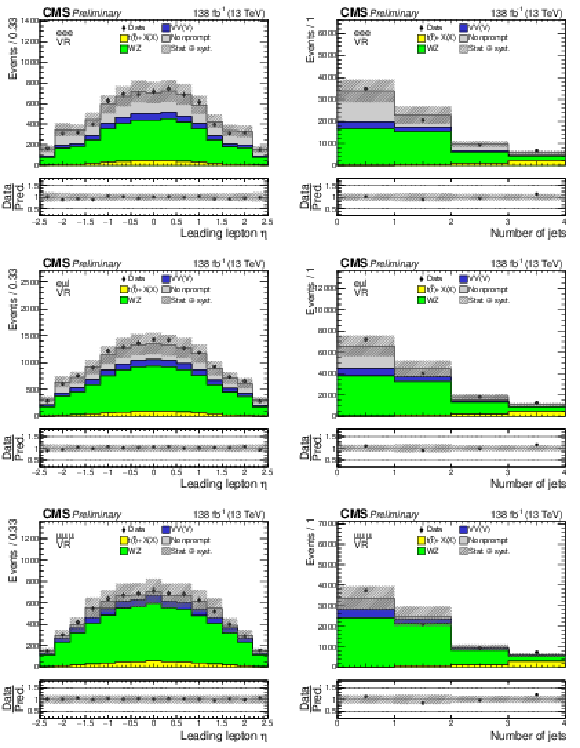
png pdf |
Figure 2:
Distributions of the leading lepton η (left column) and the jet multiplicity (right column). Events in the eee VR, eμℓ VR, and μμμ VR are shown in upper, middle, and lower row, respectively. The data are shown as filled points and the SM background predictions as histograms. The nonprompt backgrounds are estimated using a data-driven technique while other backgrounds are estimated using MC simulation. The hatched bands indicate statistical and systematic uncertainties for the SM background predictions. The last bin of all histograms in the right column includes overflow. |
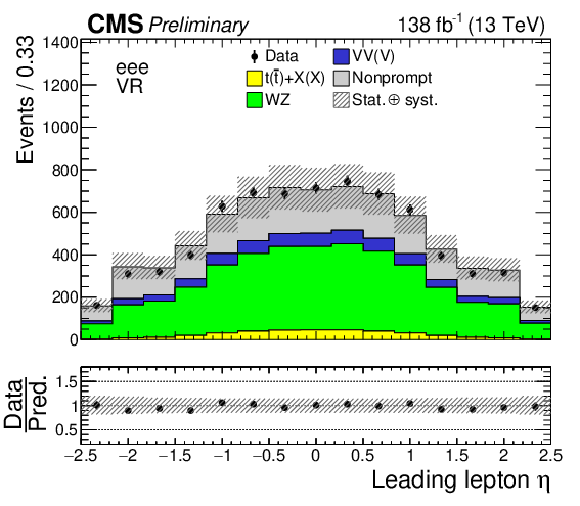
png pdf |
Figure 2-a:
Distributions of the leading lepton η (left column) and the jet multiplicity (right column). Events in the eee VR, eμℓ VR, and μμμ VR are shown in upper, middle, and lower row, respectively. The data are shown as filled points and the SM background predictions as histograms. The nonprompt backgrounds are estimated using a data-driven technique while other backgrounds are estimated using MC simulation. The hatched bands indicate statistical and systematic uncertainties for the SM background predictions. The last bin of all histograms in the right column includes overflow. |

png pdf |
Figure 2-b:
Distributions of the leading lepton η (left column) and the jet multiplicity (right column). Events in the eee VR, eμℓ VR, and μμμ VR are shown in upper, middle, and lower row, respectively. The data are shown as filled points and the SM background predictions as histograms. The nonprompt backgrounds are estimated using a data-driven technique while other backgrounds are estimated using MC simulation. The hatched bands indicate statistical and systematic uncertainties for the SM background predictions. The last bin of all histograms in the right column includes overflow. |

png pdf |
Figure 2-c:
Distributions of the leading lepton η (left column) and the jet multiplicity (right column). Events in the eee VR, eμℓ VR, and μμμ VR are shown in upper, middle, and lower row, respectively. The data are shown as filled points and the SM background predictions as histograms. The nonprompt backgrounds are estimated using a data-driven technique while other backgrounds are estimated using MC simulation. The hatched bands indicate statistical and systematic uncertainties for the SM background predictions. The last bin of all histograms in the right column includes overflow. |

png pdf |
Figure 2-d:
Distributions of the leading lepton η (left column) and the jet multiplicity (right column). Events in the eee VR, eμℓ VR, and μμμ VR are shown in upper, middle, and lower row, respectively. The data are shown as filled points and the SM background predictions as histograms. The nonprompt backgrounds are estimated using a data-driven technique while other backgrounds are estimated using MC simulation. The hatched bands indicate statistical and systematic uncertainties for the SM background predictions. The last bin of all histograms in the right column includes overflow. |
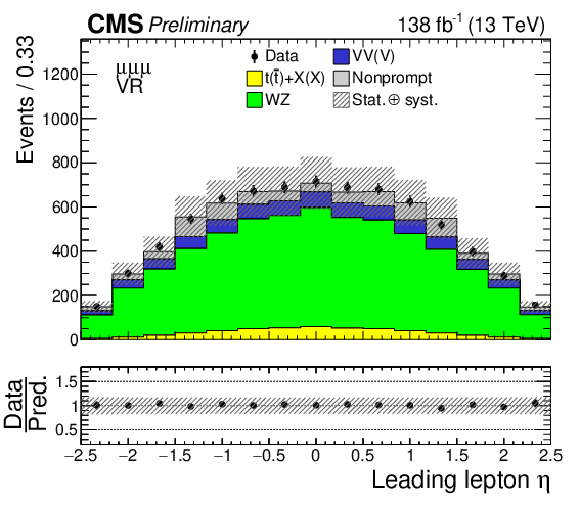
png pdf |
Figure 2-e:
Distributions of the leading lepton η (left column) and the jet multiplicity (right column). Events in the eee VR, eμℓ VR, and μμμ VR are shown in upper, middle, and lower row, respectively. The data are shown as filled points and the SM background predictions as histograms. The nonprompt backgrounds are estimated using a data-driven technique while other backgrounds are estimated using MC simulation. The hatched bands indicate statistical and systematic uncertainties for the SM background predictions. The last bin of all histograms in the right column includes overflow. |
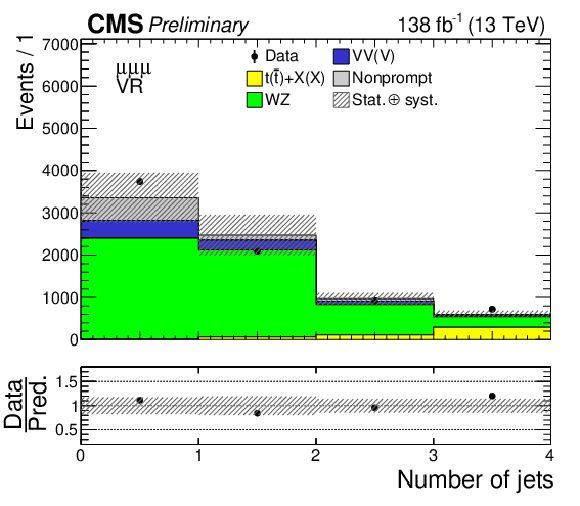
png pdf |
Figure 2-f:
Distributions of the leading lepton η (left column) and the jet multiplicity (right column). Events in the eee VR, eμℓ VR, and μμμ VR are shown in upper, middle, and lower row, respectively. The data are shown as filled points and the SM background predictions as histograms. The nonprompt backgrounds are estimated using a data-driven technique while other backgrounds are estimated using MC simulation. The hatched bands indicate statistical and systematic uncertainties for the SM background predictions. The last bin of all histograms in the right column includes overflow. |
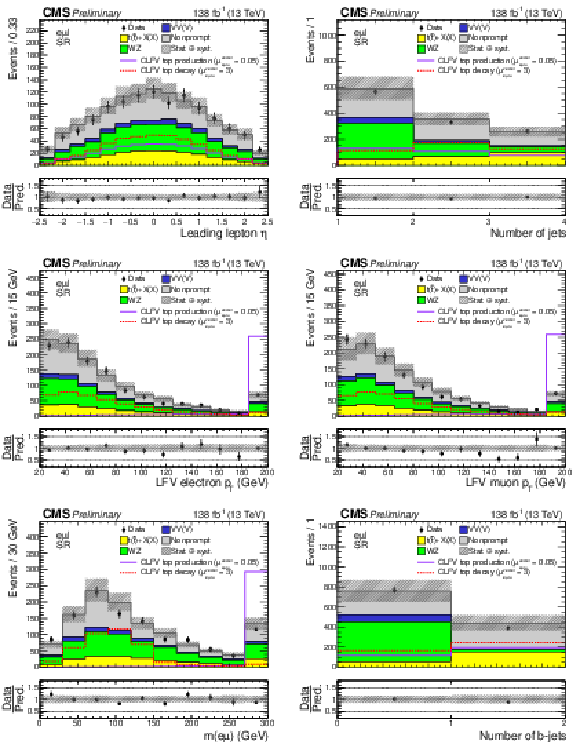
png pdf |
Figure 3:
Distributions of various variables in the SR: the leading lepton η (upper left), the jet multiplicity (upper right), LFV electron pT (middle left), LFV muon pT (middle left), LFV eμ mass (lower left), and b-jet multiplicity (lower right). The CLFV top quark decay and production signals are shown in dotted red line and solid purple line, respectively. The original signal normalization, corresponding to Cvectoreμtu/Λ2= 1 TeV−2, is scaled up (down) by a factor of 3 (20) for CLFV top quark decay (production) signal for better visualization. The hatched bands indicate statistical and systematic uncertainties for the SM background predictions. The last bin of all but the top left and bottom right histograms includes overflow. |

png pdf |
Figure 3-a:
Distributions of various variables in the SR: the leading lepton η (upper left), the jet multiplicity (upper right), LFV electron pT (middle left), LFV muon pT (middle left), LFV eμ mass (lower left), and b-jet multiplicity (lower right). The CLFV top quark decay and production signals are shown in dotted red line and solid purple line, respectively. The original signal normalization, corresponding to Cvectoreμtu/Λ2= 1 TeV−2, is scaled up (down) by a factor of 3 (20) for CLFV top quark decay (production) signal for better visualization. The hatched bands indicate statistical and systematic uncertainties for the SM background predictions. The last bin of all but the top left and bottom right histograms includes overflow. |

png pdf |
Figure 3-b:
Distributions of various variables in the SR: the leading lepton η (upper left), the jet multiplicity (upper right), LFV electron pT (middle left), LFV muon pT (middle left), LFV eμ mass (lower left), and b-jet multiplicity (lower right). The CLFV top quark decay and production signals are shown in dotted red line and solid purple line, respectively. The original signal normalization, corresponding to Cvectoreμtu/Λ2= 1 TeV−2, is scaled up (down) by a factor of 3 (20) for CLFV top quark decay (production) signal for better visualization. The hatched bands indicate statistical and systematic uncertainties for the SM background predictions. The last bin of all but the top left and bottom right histograms includes overflow. |

png pdf |
Figure 3-c:
Distributions of various variables in the SR: the leading lepton η (upper left), the jet multiplicity (upper right), LFV electron pT (middle left), LFV muon pT (middle left), LFV eμ mass (lower left), and b-jet multiplicity (lower right). The CLFV top quark decay and production signals are shown in dotted red line and solid purple line, respectively. The original signal normalization, corresponding to Cvectoreμtu/Λ2= 1 TeV−2, is scaled up (down) by a factor of 3 (20) for CLFV top quark decay (production) signal for better visualization. The hatched bands indicate statistical and systematic uncertainties for the SM background predictions. The last bin of all but the top left and bottom right histograms includes overflow. |

png pdf |
Figure 3-d:
Distributions of various variables in the SR: the leading lepton η (upper left), the jet multiplicity (upper right), LFV electron pT (middle left), LFV muon pT (middle left), LFV eμ mass (lower left), and b-jet multiplicity (lower right). The CLFV top quark decay and production signals are shown in dotted red line and solid purple line, respectively. The original signal normalization, corresponding to Cvectoreμtu/Λ2= 1 TeV−2, is scaled up (down) by a factor of 3 (20) for CLFV top quark decay (production) signal for better visualization. The hatched bands indicate statistical and systematic uncertainties for the SM background predictions. The last bin of all but the top left and bottom right histograms includes overflow. |
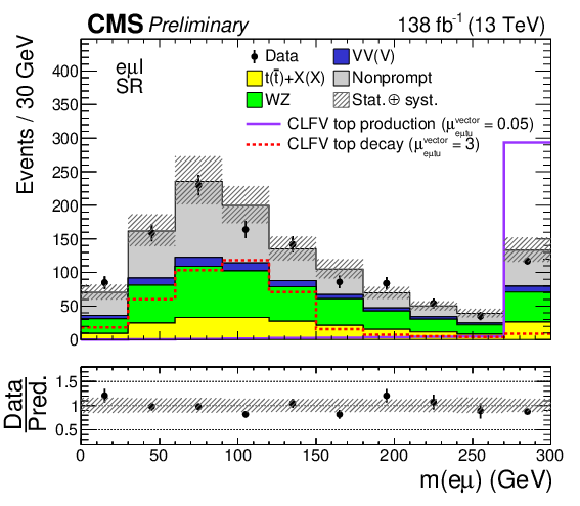
png pdf |
Figure 3-e:
Distributions of various variables in the SR: the leading lepton η (upper left), the jet multiplicity (upper right), LFV electron pT (middle left), LFV muon pT (middle left), LFV eμ mass (lower left), and b-jet multiplicity (lower right). The CLFV top quark decay and production signals are shown in dotted red line and solid purple line, respectively. The original signal normalization, corresponding to Cvectoreμtu/Λ2= 1 TeV−2, is scaled up (down) by a factor of 3 (20) for CLFV top quark decay (production) signal for better visualization. The hatched bands indicate statistical and systematic uncertainties for the SM background predictions. The last bin of all but the top left and bottom right histograms includes overflow. |
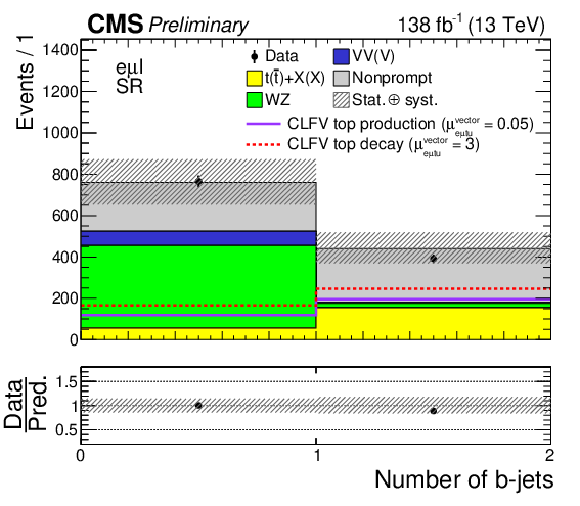
png pdf |
Figure 3-f:
Distributions of various variables in the SR: the leading lepton η (upper left), the jet multiplicity (upper right), LFV electron pT (middle left), LFV muon pT (middle left), LFV eμ mass (lower left), and b-jet multiplicity (lower right). The CLFV top quark decay and production signals are shown in dotted red line and solid purple line, respectively. The original signal normalization, corresponding to Cvectoreμtu/Λ2= 1 TeV−2, is scaled up (down) by a factor of 3 (20) for CLFV top quark decay (production) signal for better visualization. The hatched bands indicate statistical and systematic uncertainties for the SM background predictions. The last bin of all but the top left and bottom right histograms includes overflow. |
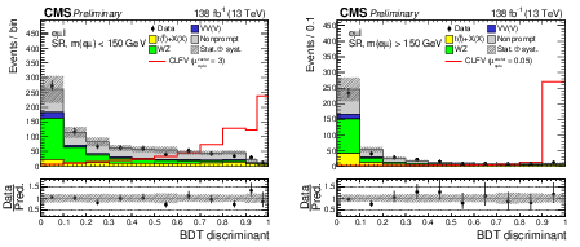
png pdf |
Figure 4:
Distributions of the BDT discriminator targeting the CLFV top quark decay (left) and production (right) signal. Contributions from CLFV top quark decay- and production-mode are combined within each SR and are shown in solid red line. The original signal normalisation, corresponding to Cvectoreμtu/Λ2= 1 TeV−2, is scaled up (down) by a factor of 3 (20) for CLFV top quark decay (production) enriched SR for better visualisation. The hatched bands indicate statistical and systematic uncertainties for the SM background predictions. |
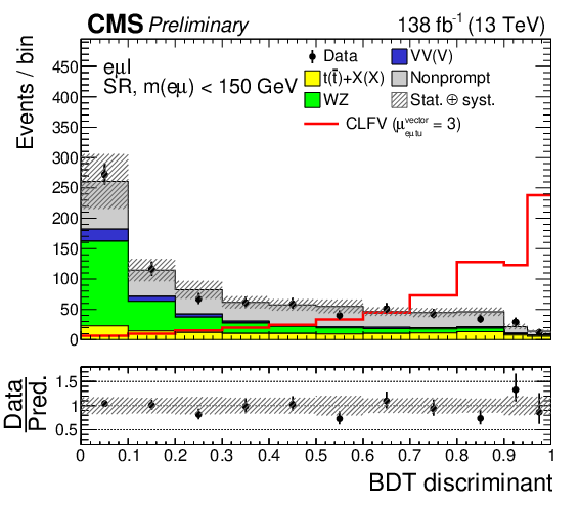
png pdf |
Figure 4-a:
Distributions of the BDT discriminator targeting the CLFV top quark decay (left) and production (right) signal. Contributions from CLFV top quark decay- and production-mode are combined within each SR and are shown in solid red line. The original signal normalisation, corresponding to Cvectoreμtu/Λ2= 1 TeV−2, is scaled up (down) by a factor of 3 (20) for CLFV top quark decay (production) enriched SR for better visualisation. The hatched bands indicate statistical and systematic uncertainties for the SM background predictions. |
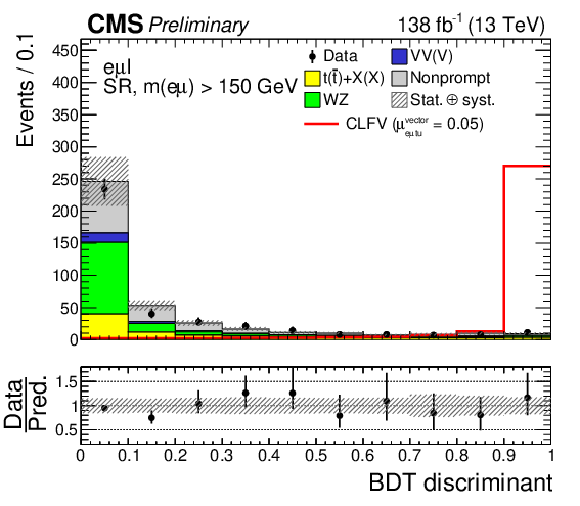
png pdf |
Figure 4-b:
Distributions of the BDT discriminator targeting the CLFV top quark decay (left) and production (right) signal. Contributions from CLFV top quark decay- and production-mode are combined within each SR and are shown in solid red line. The original signal normalisation, corresponding to Cvectoreμtu/Λ2= 1 TeV−2, is scaled up (down) by a factor of 3 (20) for CLFV top quark decay (production) enriched SR for better visualisation. The hatched bands indicate statistical and systematic uncertainties for the SM background predictions. |
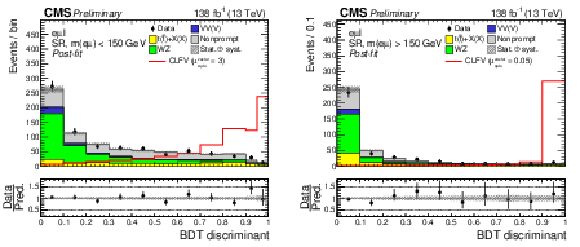
png pdf |
Figure 5:
Distributions of the posterior BDT discriminator targeting the CLFV top quark decay (left) and production (right) signal. Contributions from CLFV top quark decay- and production-mode are combined within each SR and are shown in solid red line. The original signal normalisation, corresponding to Cvectoreμtu/Λ2= 1 TeV−2, is scaled up (down) by a factor of 3 (20) for CLFV top quark decay (production) enriched SR for better visualisation. The hatched bands indicate posterior uncertainties (statistical and systematic) for the SM background predictions. |

png pdf |
Figure 5-a:
Distributions of the posterior BDT discriminator targeting the CLFV top quark decay (left) and production (right) signal. Contributions from CLFV top quark decay- and production-mode are combined within each SR and are shown in solid red line. The original signal normalisation, corresponding to Cvectoreμtu/Λ2= 1 TeV−2, is scaled up (down) by a factor of 3 (20) for CLFV top quark decay (production) enriched SR for better visualisation. The hatched bands indicate posterior uncertainties (statistical and systematic) for the SM background predictions. |
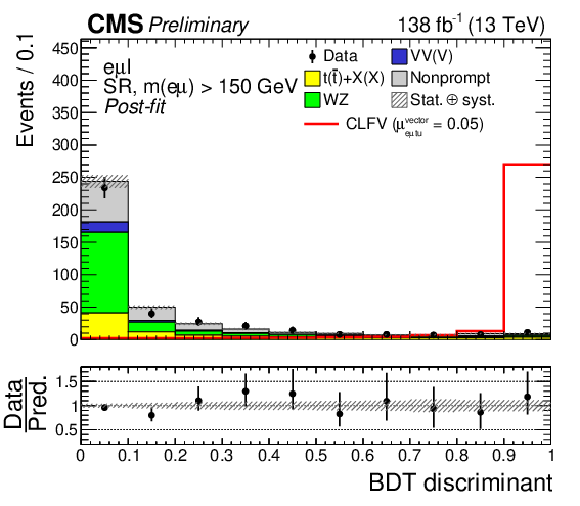
png pdf |
Figure 5-b:
Distributions of the posterior BDT discriminator targeting the CLFV top quark decay (left) and production (right) signal. Contributions from CLFV top quark decay- and production-mode are combined within each SR and are shown in solid red line. The original signal normalisation, corresponding to Cvectoreμtu/Λ2= 1 TeV−2, is scaled up (down) by a factor of 3 (20) for CLFV top quark decay (production) enriched SR for better visualisation. The hatched bands indicate posterior uncertainties (statistical and systematic) for the SM background predictions. |

png pdf |
Figure 6:
Two-dimensional 95% CL upper limits on the Wilson coefficients (left) and the branching ratios (right). The observed (expected) upper limits for tensor-, vector-, and scalar-like CLFV interactions are shown in red, blue, and black solid (dotted) line, respectively. The shaded bands contain 68% of the distribution of expected upper limits. |

png pdf |
Figure 6-a:
Two-dimensional 95% CL upper limits on the Wilson coefficients (left) and the branching ratios (right). The observed (expected) upper limits for tensor-, vector-, and scalar-like CLFV interactions are shown in red, blue, and black solid (dotted) line, respectively. The shaded bands contain 68% of the distribution of expected upper limits. |
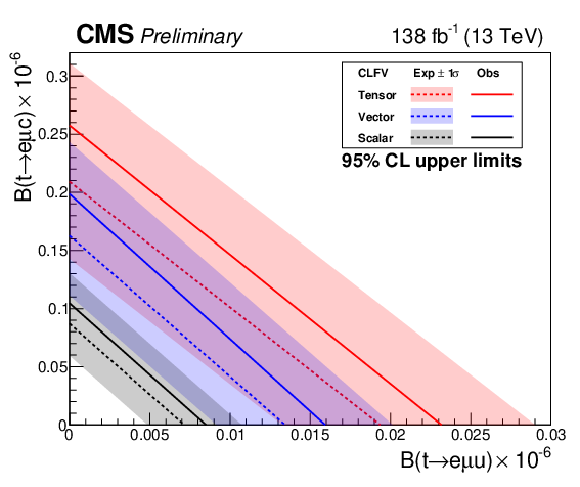
png pdf |
Figure 6-b:
Two-dimensional 95% CL upper limits on the Wilson coefficients (left) and the branching ratios (right). The observed (expected) upper limits for tensor-, vector-, and scalar-like CLFV interactions are shown in red, blue, and black solid (dotted) line, respectively. The shaded bands contain 68% of the distribution of expected upper limits. |
| Tables | |

png pdf |
Table 1:
Summary of relevant dimension-6 operators considered in this analysis. The indices i and j are lepton flavor indices that run from 1 to 2 with i≠j; k and l are quark flavor indices with the condition that one of them is 3 and the other one runs from 1 to 2. |

png pdf |
Table 2:
Summary of the selection criteria used to define different event regions. |

png pdf |
Table 3:
Expected background contributions and the number of events observed in data collected during 2016--2018. The systematic and statistical uncertainties are added in quadrature. The CLFV signal, generated with Cvectoreμtu/Λ2= 1 TeV−2, is also listed for reference. |

png pdf |
Table 4:
Upper limits at the 95% CL on the different CLFV signals obtained from the 2016--2018 data set. The observed and expected upper limits are shown in boldface and standard style, respectively. The intervals that contain 68% of the distribution of the expected upper limits are shown in parentheses. |
| Summary |
| This note presents results from a search for charged lepton flavor violation in both top quark production and decay signal processes. The data used were collected by the CMS experiment during 2016--2018 and correspond to an integrated luminosity of 138 fb−1. Events are selected for analysis if they contain exactly three charged leptons---one electron and one muon of opposite electric charge as well as one additional electron or muon. Events must also contain at least one jet and at most one jet associated with a bottom quark. An effective field theory approach is used for parametrizing the charged lepton flavor violating interactions. Boosted decision trees are used to distinguish a possible signal from the background expectation. No significant excess is observed over the prediction from the standard model. Upper limits are set on the branching ratios t→eμu (t→eμc) of 0.023 × 10−6 (0.258 × 10−6), 0.016 × 10−6 (0.199 × 10−6), and 0.009 × 10−6 (0.105 × 10−6) for tensor, vector, and scalar interactions, respectively. |
| References | ||||
| 1 | Super-Kamiokande Collaboration | Evidence for oscillation of atmospheric neutrinos | PRL 81 (1998) 1562 | hep-ex/9807003 |
| 2 | SNO Collaboration | Direct evidence for neutrino flavor transformation from neutral current interactions in the Sudbury Neutrino Observatory | PRL 89 (2002) 011301 | nucl-ex/0204008 |
| 3 | S. Davidson, M. L. Mangano, S. Perries, and V. Sordini | Lepton flavour violating top decays at the LHC | EPJC 75 (2015) 450 | 1507.07163 |
| 4 | LHCb Collaboration | Measurement of the ratio of branching fractions B(ˉB0→D∗+τ−ˉντ)/B(ˉB0→D∗+μ−ˉνμ) | PRL 115 (2015) 111803 | 1506.08614 |
| 5 | LHCb Collaboration | Measurement of the ratios of branching fractions R(D∗) and R(D0) | Submitted to PRL, 2023 | 2302.02886 |
| 6 | T. J. Kim et al. | Correlation between RD(∗) and top quark FCNC decays in leptoquark models | JHEP 07 (2019) 025 | 1812.08484 |
| 7 | CMS Collaboration | Search for charged-lepton flavor violation in top quark production and decay in pp collisions at √s = 13 TeV | JHEP 06 (2022) 082 | CMS-TOP-19-006 2201.07859 |
| 8 | ATLAS Collaboration | Search for charged lepton-flavour violation in top-quark decays at the LHC with the ATLAS detector | ATLAS CONF Note ATLAS-CONF-2018-044, 2018 | |
| 9 | ATLAS Collaboration | Search for charged-lepton-flavour violating μτqt interactions in top-quark production and decay with the ATLAS detector at the LHC | ATLAS CONF Note ATLAS-CONF-2023-001, 2023 | |
| 10 | B. Grzadkowski, M. Iskrzyński, M. Misiak, and J. Rosiek | Dimension-six terms in the standard model lagrangian | JHEP 10 (2010) 85 | 1008.4884 |
| 11 | CMS Collaboration | The CMS experiment at the CERN LHC | JINST 3 (2008) S08004 | |
| 12 | CMS Collaboration | Performance of the CMS Level-1 trigger in proton-proton collisions at √s= 13 TeV | JINST 15 (2020) P10017 | CMS-TRG-17-001 2006.10165 |
| 13 | CMS Collaboration | The CMS trigger system | JINST 12 (2017) P01020 | CMS-TRG-12-001 1609.02366 |
| 14 | J. Alwall et al. | The automated computation of tree-level and next-to-leading order differential cross sections, and their matching to parton shower simulations | JHEP 07 (2014) 079 | 1405.0301 |
| 15 | I. Brivio, Y. Jiang, and M. Trott | The SMEFTsim package, theory and tools | JHEP 12 (2017) 070 | 1709.06492 |
| 16 | A. Dedes et al. | SmeftFR - Feynman rules generator for the Standard Model Effective Field Theory | Comput. Phys. Commun. 247 (2020) 106931 | 1904.03204 |
| 17 | P. Nason | A new method for combining NLO QCD with shower Monte Carlo algorithms | JHEP 11 (2004) 040 | hep-ph/0409146 |
| 18 | S. Frixione, P. Nason, and C. Oleari | Matching NLO QCD computations with parton shower simulations: the POWHEG method | JHEP 11 (2007) 070 | 0709.2092 |
| 19 | S. Alioli, P. Nason, C. Oleari, and E. Re | A general framework for implementing NLO calculations in shower Monte Carlo programs: the POWHEG box | JHEP 06 (2010) 043 | 1002.2581 |
| 20 | J. M. Campbell, R. K. Ellis, P. Nason, and E. Re | Top-pair production and decay at NLO matched with parton showers | JHEP 04 (2015) 114 | 1412.1828 |
| 21 | NNPDF Collaboration | Parton distributions for the LHC Run II | JHEP 04 (2015) 040 | 1410.8849 |
| 22 | T. Sjöstrand et al. | An introduction to PYTHIA 8.2 | Comput. Phys. Commun. 191 (2015) 159 | 1410.3012 |
| 23 | P. Skands, S. Carrazza, and J. Rojo | Tuning PYTHIA 8.1: the Monash 2013 Tune | EPJC 74 (2014) 3024 | 1404.5630 |
| 24 | NNPDF Collaboration | Parton distributions from high-precision collider data | EPJC 77 (2017) 663 | 1706.00428 |
| 25 | CMS Collaboration | Extraction and validation of a new set of CMS PYTHIA8 tunes from underlying-event measurements | EPJC 80 (2020) 4 | CMS-GEN-17-001 1903.12179 |
| 26 | S. Agostinelli et al. | GEANT 4---a simulation toolkit | NIM A 506 (2003) 250 | |
| 27 | CMS Collaboration | Particle-flow reconstruction and global event description with the CMS detector | JINST 12 (2017) P10003 | CMS-PRF-14-001 1706.04965 |
| 28 | CMS Collaboration | Technical proposal for the Phase-II upgrade of the Compact Muon Solenoid | CMS Technical Proposal CERN-LHCC-2015-010, CMS-TDR-15-02, 2015 CDS |
|
| 29 | M. Cacciari, G. P. Salam, and G. Soyez | The anti-kT jet clustering algorithm | JHEP 04 (2008) 063 | 0802.1189 |
| 30 | M. Cacciari, G. P. Salam, and G. Soyez | FastJet user manual | EPJC 72 (2012) 1896 | 1111.6097 |
| 31 | M. Cacciari and G. P. Salam | Dispelling the N3 myth for the kt jet-finder | PLB 641 (2006) 57 | hep-ph/0512210 |
| 32 | CMS Collaboration | Jet energy scale and resolution in the CMS experiment in pp collisions at 8 TeV | JINST 12 (2017) P02014 | CMS-JME-13-004 1607.03663 |
| 33 | CMS Collaboration | Performance of missing transverse momentum reconstruction in proton-proton collisions at √s= 13 TeV using the CMS detector | JINST 14 (2019) P07004 | CMS-JME-17-001 1903.06078 |
| 34 | CMS Collaboration | Inclusive and differential cross section measurements of single top quark production in association with a Z boson in proton-proton collisions at √s= 13 TeV | JHEP 02 (2022) 107 | CMS-TOP-20-010 2111.02860 |
| 35 | CMS Collaboration | Identification of heavy-flavour jets with the CMS detector in pp collisions at 13 TeV | JINST 13 (2018) P05011 | CMS-BTV-16-002 1712.07158 |
| 36 | E. Bols et al. | Jet flavour classification using DeepJet | JINST 15 (2020) P12012 | 2008.10519 |
| 37 | CMS Collaboration | Performance of the DeepJet b tagging algorithm using 41.9 fb−1 of data from proton-proton collisions at 13 TeV with Phase 1 CMS detector | CMS Detector Performance Note CMS-DP-2018-058, 2018 CDS |
|
| 38 | CMS Collaboration | Measurement of the t¯t production cross section in the dilepton channel in pp collisions at √s= 7 TeV | JHEP 11 (2012) 067 | CMS-TOP-11-005 1208.2671 |
| 39 | T. Chen and C. Guestrin | XGBoost: A scalable tree boosting system | in ACM SIGKDD International Conference on Knowledge Discovery and Data Mining, KDD '16, ACM, New York, 2016 Proceedings of the 2 (2016) 785 |
|
| 40 | CMS Collaboration | Precision luminosity measurement in proton-proton collisions at √s= 13 TeV in 2015 and 2016 at CMS | EPJC 81 (2021) 800 | CMS-LUM-17-003 2104.01927 |
| 41 | CMS Collaboration | CMS luminosity measurement for the 2017 data-taking period at √s = 13 TeV | CMS Physics Analysis Summary, 2018 link |
CMS-PAS-LUM-17-004 |
| 42 | CMS Collaboration | CMS luminosity measurement for the 2018 data-taking period at √s = 13 TeV | CMS Physics Analysis Summary, 2019 link |
CMS-PAS-LUM-18-002 |
| 43 | CMS Collaboration | Measurement of the inelastic proton-proton cross section at √s= 13 TeV | JHEP 07 (2018) 161 | CMS-FSQ-15-005 1802.02613 |
| 44 | CMS Collaboration | Electron and photon reconstruction and identification with the CMS experiment at the CERN LHC | JINST 16 (2021) P05014 | CMS-EGM-17-001 2012.06888 |
| 45 | CMS Collaboration | Performance of the CMS muon detector and muon reconstruction with proton-proton collisions at √s= 13 TeV | JINST 13 (2018) P06015 | CMS-MUO-16-001 1804.04528 |
| 46 | J. Butterworth et al. | PDF4LHC recommendations for LHC Run II | JPG 43 (2016) 023001 | 1510.03865 |
| 47 | R. J. Barlow and C. Beeston | Fitting using finite Monte Carlo samples | Comput. Phys. Commun. 77 (1993) 219 | |
| 48 | T. Junk | Confidence level computation for combining searches with small statistics | NIM A 434 (1999) 435 | hep-ex/9902006 |
| 49 | A. Read | Presentation of search results: The CLs technique | Journal of Physics G:, 2002 Nuclear and Particle Physics 28 (2002) 2693 |
|
| 50 | G. Cowan, K. Cranmer, E. Gross, and O. Vitells | Asymptotic formulae for likelihood-based tests of new physics | EPJC 71 (2011) 1554 | 1007.1727 |
| 51 | J. Kile and A. Soni | Model-independent constraints on lepton-flavor-violating decays of the top quark | PRD 78 (2008) 094008 | 0807.4199 |

|
Compact Muon Solenoid LHC, CERN |

|

|

|

|

|

|